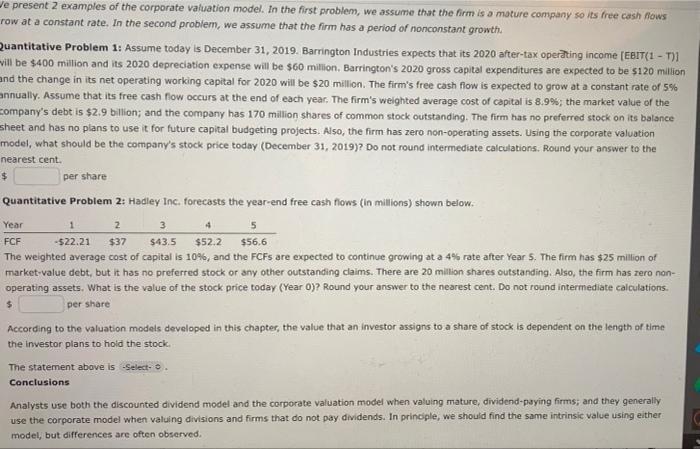Je present 2 examples of the corporate valuation model. In the first problem, we assume that the firm is a mature company so its free cash flows row at a constant rate. In the second problem, we assume that the firm has a period of nonconstant growth Quantitative Problem 1: Assume today is December 31, 2019. Barrington Industries expects that its 2020 after-tax operating income (EBIT(1 - TI will be $400 million and its 2020 depreciation expense will be $60 milion, Barrington's 2020 gross capital expenditures are expected to be $120 million and the change in its net operating working capital for 2020 will be $20 million. The firm's free cash flow is expected to grow at a constant rate of 5% annually. Assume that its free cash flow occurs at the end of each year. The firm's weighted average cost of capital is 8.9%; the market value of the company's debt is $2.9 billion; and the company has 170 million shares of common stock outstanding. The firm has no preferred stock on its balance Sheet and has no plans to use it for future capital budgeting projects. Also, the firm has zero non-operating assets. Using the corporate valuation model, what should be the company's stock price today (December 31, 2019)? Do not round intermediate calculations. Round your answer to the nearest cent. per share 2 4 5 Year FCF Quantitative Problem 2: Hadley Inc. forecasts the year-end free cash flows (in millions) shown below. 1 3 -$22.21 $37 $43.5 $52.2 $56,6 The weighted average cost of capital is 10%, and the FCFs are expected to continue growing at a 4% rate after Year S. The firm has $25 million of market value debt, but it has no preferred stock or any other outstanding claims. There are 20 million shares outstanding. Also, the firm has zero non- operating assets. What is the value of the stock price today (Year O)? Round your answer to the nearest cent. Do not round intermediate calculations. per share According to the valuation models developed in this chapter, the value that an investor assigns to a share of stock is dependent on the length of time the investor plans to hold the stock The statement above is -Select- Conclusions Analysts use both the discounted dividend model and the corporate valuation model when valuing mature, dividend paying firms; and they generally use the corporate model when valuing divisions and firms that do not pay dividends. In principle, we should find the same intrinsic value using either model, but differences are often observed







